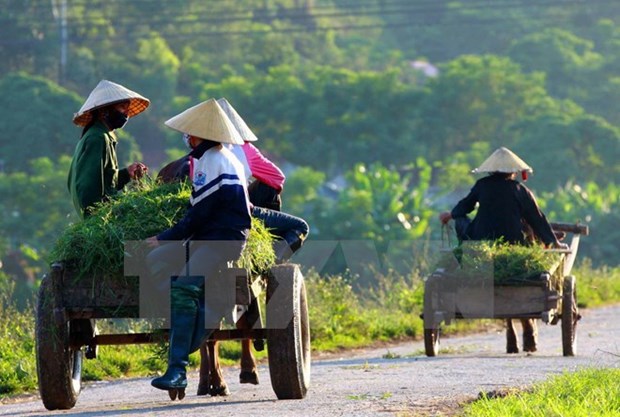Lawmakers review rural construction, agricultural restructuring
Legislators examined inspection outcomes of the implementation of the national target programme on new-style rural areas for 2010-2015 in combination with agricultural restructuring.
 Illustrative image (Source: VNA)
Illustrative image (Source: VNA)According to a report presented by the National Assembly Standing Committee, thanks to the programme, rural areas have been given facelifts, especially the transport system and social infrastructure.
So far, 2,061 communes or 23 percent of the total communes and 27 districts nationwide have been recognised as new-style rural areas. The rates of communes achieving criteria on planning, security and social order, electricity, education, irrigation and income improved significantly over the past five years.
Household poverty rate dropped from 17.4 percent in 2011 to 8.2 percent in 2015. Per capital income in the modern communes rose from 16 million VND (720 USD) to 28.4 million VND (roughly 1,280 USD) per year during this period.
Between 2010 and 2015, more than 851 trillion VND (38.3 billion USD) were mobilised for the programme. The legislature also allocated 15 trillion VND (675 million USD) sourced from Government bonds to the work during the 2014-2016 period, the report said.
At the same time, the agricultural restructuring project has helped raise farmers’ income, shift labour structure in the farming sector and develop new rural areas sustainably.
However, the parliamentary inspection delegation pointed to limitations in the work, including the big gap between set standards and the particular conditions in various regions, areas and localities. The slow issuance of documents guiding the realisation of national criteria on new rural areas also hindered the implementation process.
The Prime Minister’s Decision No. 800/QD-TTg dated on June 4, 2010 targets 20 percent of communes recognised as new rural areas in 2015. However, the target was not fulfilled, the inspectors said.
Besides, there is a big gap in the rates of new rural communes among regions, with 46.4 percent recorded in the Southeast region, 42.8 percent in the Red River Delta, 8.2 percent in northern mountainous localities, 13.2 percent in the Central Highlands and 16.7 percent in the Mekong Delta.
A serious problem in the implementation of the new rural area programme is the big outstanding debts incurred by local authorities, mostly in capital construction, which amounted to 15.2 trillion VND. Localities in the Red River Delta and the central north region accounted for 75.3 percent of the total debts.
In addition, many localities have not realised the importance of agricultural restructuring to the building of new style rural areas. Therefore, they have been slow in building and carrying out projects aimed at restructuring agricultural production. Others have failed to include the restructuring project with the new style rural area programme.
The role of cooperatives have not received due attention, the inspectors stressed.
Given this, they suggested the Government continue keeping a close watch on the application of the criteria during 2016-2020 for timely adjustment.
They also underlined the need to promptly issue documents guiding the implementation of the programme in details.
The Government should draft supplements and adjustments to laws regarding agriculture and rural areas and submit to the National Assembly in order to facilitate the building of rural areas and agricultural restructuring, they said.
To address the outstanding debt, the Government should prioritise allocating capital to localities to pay debts before starting new projects, and build a roadmap to pay all debts before 2019 while preventing any new debt from occurring.
The inspectors also suggested issuing more policies encouraging businesses to invest in rural areas as well as start-ups in agriculture, and connecting farmers with the State, businesses and scientists.
Land-related polices should be renewed in order to step up large-scale production while ensuring land use rights of farmers, they said.-VNA













